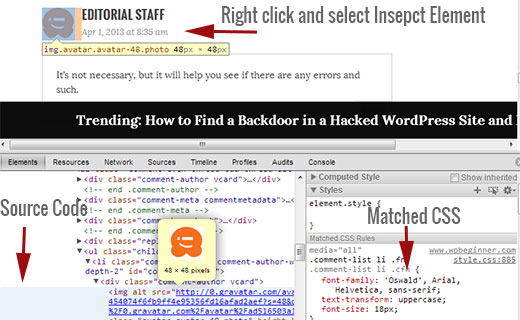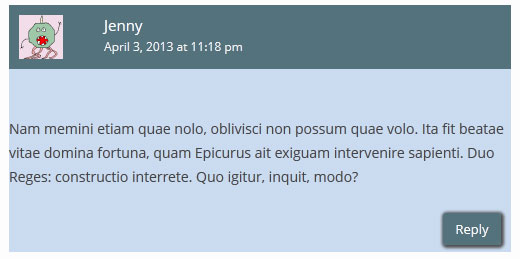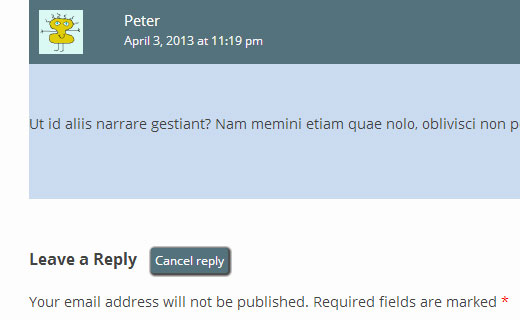How to Style Your WordPress Comments Layout
Recently we showed you how to style the WordPress comment form, and we thought it would be incomplete if we did not write about styling WordPress comments layout. In the past, we have discussed that there are default WordPress generated CSS classes and IDs to help make it easier for theme designers to style their templates. In this article, we will be using those default classes to show you how to style your WordPress comments layout and some of the cool things you can do with it.
For the sake of this example, We will be modifying the default Twenty Twelve WordPress theme in this article. Note: This article is for beginning theme designers and DIY users who have fair understanding of HTML and CSS.
Default WordPress Comments Classes
By default WordPress generates these classes for elements in the comments template:
/*Comment Output*/ .commentlist .reply {} .commentlist .reply a {} .commentlist .alt {} .commentlist .odd {} .commentlist .even {} .commentlist .thread-alt {} .commentlist .thread-odd {} .commentlist .thread-even {} .commentlist li ul.children .alt {} .commentlist li ul.children .odd {} .commentlist li ul.children .even {} .commentlist .vcard {} .commentlist .vcard cite.fn {} .commentlist .vcard span.says {} .commentlist .vcard img.photo {} .commentlist .vcard img.avatar {} .commentlist .vcard cite.fn a.url {} .commentlist .comment-meta {} .commentlist .comment-meta a {} .commentlist .commentmetadata {} .commentlist .commentmetadata a {} .commentlist .parent {} .commentlist .comment {} .commentlist .children {} .commentlist .pingback {} .commentlist .bypostauthor {} .commentlist .comment-author {} .commentlist .comment-author-admin {} .commentlist {} .commentlist li {} .commentlist li p {} .commentlist li ul {} .commentlist li ul.children li {} .commentlist li ul.children li.alt {} .commentlist li ul.children li.byuser {} .commentlist li ul.children li.comment {} .commentlist li ul.children li.depth-{id} {} .commentlist li ul.children li.bypostauthor {} .commentlist li ul.children li.comment-author-admin {} #cancel-comment-reply {} #cancel-comment-reply a {}
How to Find Which CSS Classes You Need to Edit
Before we move on to styling WordPress comments layout, a little tip for our new users. Google Chrome and Mozilla Firefox web browsers come with a handy tool that you can use to improve your WordPress theme development skills. The tool is called Inspect Element. Simply take your mouse to an element on a web page, right click and choose inspect element. Your browser window will split into two rows and in the lower window you will see the source code of that element. Also in the lower window, you will be able to see CSS elements and how they are styled. You can even edit the CSS in there for testing purposes. It’s important to remember, anything you change using the Inspect Element is only visible to you. The moment you refresh the page, those changes will disappear. To make the changes permanent, you have to use your style.css file or other appropriate files in your themes.

Adding Odd and Even Background Colors for Comments
Having a different background color for odd and even comments is a design trend that has been around for some years now. It helps the readability specially if you have a lot of comments. It also looks really good with certain theme colors which is why many designers want to utilize this functionality. To help designers achieve this goal, WordPress adds an odd and even class to each comment respectively.
You can easily add the odd/even styling for comments in your theme’s style.css by pasting the following code.
.commentlist .even .comment { background-color:#ccddf2; } .commentlist .odd .comment { background-color:#CCCCCC; }
The result would look something like this:

Styling Comment Author and Meta Information
WordPress also adds classes to elements displayed in each comment header. This allows theme designers to customize the display of author information and other comment meta such as comment date and time. Here is a sample code to paste in your theme’s style.css file to style these elements differently. In this example we have added background color to comment meta along with some spacing.
.comments-area article header { margin: 0 0 48px; overflow: hidden; position: relative; background-color:#55737D; color:#FFFFFF; padding: 10px; }
This is how it should look like:

Styling Post Author Comments Differently
Often times you might see that post author comments are highlighted either with a different background color or some additional badge. WordPress adds a default class bypostauthor to all comments made by the post’s author. WordPress theme designers can use this class to style post author comments differently.
Some themes, use their own callback function to display comments. Using the callback function, these themes may add additional information to a comment by post author. For example, Twenty Twelve uses the following line in the comment callback function twentytwelve_comment() (located in functions.php file of the theme).
// If current post author is also comment author, make it known visually. ( $comment->user_id === $post->post_author ) ? '<span> ' . __( 'Post author', 'twentytwelve' ) . '</span>' : '' );
This code adds <span>Post Author</span> to the comment meta information. Depending on how your WordPress theme handles comments by the post author, you can modify that to anything you want.
If you are using a different theme than Twenty Twelve, then you need to find out how your theme handles comments. Simply open your theme’s comments.php file. If your theme is using its own callback function, then you would see it inside wp_list_comments function, like this:
<?php wp_list_comments( array( 'callback' => 'twentytwelve_comment', 'style' => 'ol' ) ); ?>
In the above example, you can see that the theme is using twentytwelve_comment as the callback function. If a callback function is specified, then the most probable location to find this function is in your theme’s functions.php file.
In this example we are changing this function to display Editor instead of Post Author. To do that we have modified the comment callback function like this:
// If current post author is also comment author, make it known visually. ( $comment->user_id === $post->post_author ) ? '<span> ' . __( 'Editor', 'twentytwelve' ) . '</span>' : '');
We are also going to modify the way it looks by adding the following in our theme’s style.css file like this:
li.bypostauthor cite span { color: #21759b; background-color: #f8f0cb; background-image: none; border: 1px solid #f8f0cb; border-radius: 3px; box-shadow: none; padding: 3px; font-weight:bold; }
This is how it would look like:

Styling Comment Reply Link in WordPress Comments
Most WordPress themes have a reply link below each comment. This functionality is only displayed if you have threaded comments enabled. To enable threaded comments, go to your WordPress admin (Settings » Discussion). Look at the section where it says other comment settings, and check the box for enable threaded (nested) comments.
The default CSS classes generated by WordPress for the reply link are reply and comment-reply-link. We will be using those classes to modify the reply link and turn into a CSS button.
.reply { float:right; margin:0 10px 10px 0; text-align:center; background-color: #55737D; border:1px solid #55737D; border-radius:3px; padding:3px; width:50px; box-shadow: 1px 1px 2px 2px #4f4f4f; } .comment article { padding-bottom:2.79rem; } a.comment-reply-link, a.comment-edit-link { color: #FFFFFF; font-size: 13px; font-size: 0.928571429rem; line-height: 1.846153846; text-decoration:none; } a.comment-reply-link:hover, a.comment-edit-link:hover { color: #f6e7d7; }
This is how it would look like:

Styling Comment Edit Button
In most WordPress themes, logged in users with the capability to edit comments can see a comment edit link below each comment. Here is a little CSS that uses the default class comment-edit-link to modify the appearance of the link.
a.comment-edit-link { float:left; margin:0 0 10px 10px; text-align:center; background-color: #55737D; border:1px solid #55737D; border-radius:3px; padding:3px; width:50px; box-shadow: 1px 1px 2px 2px #4f4f4f; }
Here is how it would look like:

Styling Cancel Comment Reply Link
In most good WordPress themes, clicking on the Reply link opens up the comment form just below the comment you are replying to with a link to cancel comment reply. Lets modify this cancel comment reply link by using the default CSS ID cancel-comment-reply.
#cancel-comment-reply-link { text-align:center; background-color: #55737D; border:1px solid #55737D; border-radius:3px; padding:3px; width:50px; color:#FFFFFF; box-shadow: 1px 1px 2px 2px #4f4f4f; text-decoration:none; }
Here is how it would look like:

Styling the WordPress Comment Form
Usable, aesthetically pleasant and stylish comment forms encourage users to leave a comment on your blog. Earlier we have written a detailed article about how to style WordPress comment form. We would highly recommend that you go check that out to see how you can take your WordPress comment form to next level.
We hope that this article helps you style your WordPress comments layout. If you have any questions or suggestions, then please feel free to let us know by leaving a comment below.
